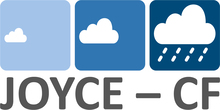Projects at JOYCE-CF
Ongoing projects
ACTRIS
Aerosol Cloud and Trace Gas Research Infrastructure (2010-ongoing)
JuCol has been part of the ground-based cloud observation network (Cloudnet) since 2010. ACTRIS is now in the process of establishing a long-term sustainable European research infrastructure. JOYCE-CF is planned to be part of the Cloud remote sensing centre with the focus on passive microwave remote sensing.
Homepage ACTRIS
HD(CP)²
High definition Clouds and Precipitation for Climate Prediciton (2013-2019), funded by BMBF
JOYCE-CF was a core part of the ground-based observing system within HD(CP)² for improved representation of clouds and precipitation in models. In the first phase of the project, JuCol hosted the HD(CP)² Observation Prototype Experiment (HOPE) with additional instrumentation, such as three ground-based supersites, and frequent radiosoundings over a period of two months in 2013 (Macke et al, 2017)
Homepage HD(CP)²
HErZ
Hans-Ertel-Zentrum (2011 - ongoing)
In the Hans-Ertel-Zentrum research to improve weather prediction and climte monitoring is carried out. Thereby the German Weather Service (Deutscher Wetterdienst, DWD) is able to respond to the challenges facing its customers. An internationally visible competence centre is being established, creationg an network between the DWD and leading meteorological institutuions in Germany, including the Ludwig-Maximilians-Universität München, Max Planck Institut für Meteorologie Universität Hambug, Goethe-Universität Frankfurt, Universität Bonn, Universität zu Köln, Freie Universität Berlin, and the Max Planck Institut für Bildungsforschung.
The Hans Ertel Centre for Weather Research is focused on the following research areas:
- Atmospheric dynamics and predictability
- Data assimilation
- Model development
- Climate monitoring and diagnostic
- Optimal use of information from weather forecasts and climate monitoring for the benefit of society
Along with the cross-cutting theme: “The optimal use of appropriate observing systems”.
Homepage HErZ
SPP-PROM
Polarimetric Radar Observations Meet Modelling (2018-ongoing), funded by DFG
Clouds and precipitation processes are still the main source for uncertainties in weather prediction and climate change since decades. With the fusion of radar polarimetry, numerical atmospheric modelling and data assimilation these uncertainties are reduced by an improved understanding of clouds and precipitation processes. Since 2015 whole Germany is covered by 16 polarimetric C-band radars and with JOYCE-CF an embedded research are for clouds and precipitation offers an ideal data base for research of SPP-PROM.
Homepage SPP-PROM
RealPEP
Near-Realtime Quantitative Precipitation Estimation and Prediction (2018-ongoing), funded by DFG
Near-realtime quantitative precipitation estimation is of high importance for applications in meteorology, hydrology, agriculture, construction, water and sewer system management. Area-covering polarimetric weather radars provide the undisputed core information for quantitative precipitation estimation (QPE) and quantitative precipitation nowcasting (QPN). RealPEP will advance QPE/QPN to verifiably outperform rain gauge observations when employed for flood predictions in small to medium-sized catchments. To this goal radar polarimetry will be combined with attenuation estimates from commercial microwave link networks for QPE improvement. In addition, information on convection initiation and evolution from satellites and lightning counts from surface networks will be exploited for QPN improvement. With increasing forecast horizons the predictive power of observation-based nowcasting quickly deteriorates and is outperformed by Numerical Weather Prediction (NWP) based on data assimilation, which fails, however, for the first hours due to the lead time required for model integration and spin-up. RealPEP will merge observation-based QPN with NWP towards seamless prediction in order to provide optimal forecasts of surface precipitation from the time of observation to days ahead.
TR32
Transregional Collaborative Research Centre 32 – Patterns in Soil-Vegetation-Atmosphere-Systems (2007-2018), funded by DFG
In order to quantify exchange processes between the atmosphere and soil/vegetation, detailed knowledge of the atmospheric fluxes of moisture, heat and momentum is necessary. JuCol was established in 2008 during the first phase of TR32 in order to setup a ground-based remote sensing supersite with the focus of boundary layer and cloud processes.
Homepage TR32
Former projects
ITARS
Initial Training for Atmospheric Remote Sensing (2012-2016)
ITaRS was bringing together universities, research organizations and high-tech companies from different disciplines with the aim to further develop the area of atmospheric remote sensing. Over four years, they trained 16 PhD students and young post-docs in this Marie Sklodowska-Curie Initial Training Network. Two of the projects were hosted by the University of Cologne. The PhD students developed new methods using JOYCE-CF instruments and data.
Homepage ITARS


